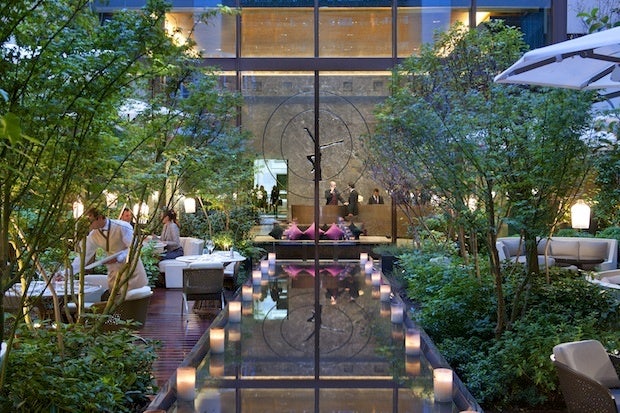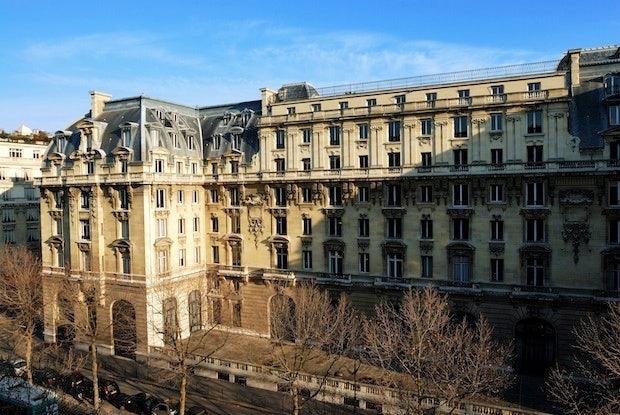
The garden outside the lobby at the Mandarin Oriental Paris.
Armed with the know-how of pleasing Chinese tourists, Asian-branded hotels are rapidly expanding into Europe to meet the needs of mainland travelers in popular destinations such as Paris.
Paris continues to attract well-heeled Chinese travelers, with a whopping 1.4 million visitors flocking to the French capital last year. And the momentum of travelers to the City of Light isn’t showing signs of slowing down—France dropped to second place after Australia for luxury mainland tourists according to the 2014 Hurun Report, but the lines outside name-brand boutiques haven't wavered. The continued allure among luxury goods lovers, honeymooners, and bus tours has the city rolling out the red carpet for the influx of Chinese tourists in recent years. Following in the footsteps of neighboring Germany, France has also put into place a fast-track visa system earlier this year, which will cut the visa application process for Chinese tourists to just two days.
No industry has been making a greater effort to please travelers coming from China than the hospitality sector. With the unveiling of The Peninsula palace slated for August 2014 and the recent opening of Shangri-La Paris in 2010, as well as the Mandarin Oriental Paris in 2011, Asian brand names are importing their savoir-faire in meeting the needs of China’s jet set.

A suite at the new Shangri-La Paris.
The opening of Shangri-La Paris in 201o marked the Hong Kong-based brand’s first property in Europe. For its European flagship, the luxury hotel chain saw the brilliant renovation of the 19th-century apartment of Roland Bonaparte—the grand nephew of Napoleon Bonaparte. Located just across the Seine from the Eiffel Tower in the upscale 16th arrondissement—home to some of the most expensive real estate in Europe—the posh district is also a hub for Asian arts with the Musée Guimet, which houses Europe’s most extensive Asian art collection, within walking distance.
Chinese guests staying at the historic hotel are greeted by dedicated Mandarin-speaking staff members, and are made to feel at home with several Asian dining options. "As well as a Chinese breakfast and Asian dishes for lunch and for dinner at La Bauhinia, [we have] Shang Palace, our one-Michelin star Chinese restaurant that is unique in Paris," says general manager Stefan Bollhalder. “Guests feel like they’re home in China!” Since opening in 2013, well-heeled Chinese account for 15 percent of the hotel’s guests. Numbers are expected to increase as a trickle-down effect of the luxury brand continues to increase its market share and brand exposure on the mainland, with six more Shangri-La hotels slated to open this year in China alone.
The Paris property is also a popular destination for moneyed Chinese honeymooners, who snap engagement photos of the hotel’s beautifully restored salons that feature ornate, fin-de-siècle interiors bearing the crests and symbols of the Bonaparte family.

The Peninsula's new Paris location.
For dining, Shangri-La Paris caters to Chinese taste buds by importing its Michelin starred restaurant, Shang Palace, from its Hong Kong headquarters to its European flagship. The restaurant is one of the few Cantonese fine dining restaurants in Paris, despite the capital city having a large concentration of Chinese residents.
Chinese motifs takes on a more muted, modern approach at The Mandarin Oriental Paris, through a palette of warm chocolate tones and slick silver and orchid-hued decor. It positions itself as a plush Parisian luxury hotel located among chic, high-end fashion boutiques in the 1st arrondissement—located a short stroll away from the prestigious Place de Vendôme. “Asian guests represent 11 percent of our total guests. Most of them come from Hong Kong, but the share of guests from the mainland is increasing very fast,” says general manager Philippe Leboeuf, who views adapting to Chinese tourists a necessity: “Today, it’s a must as the share of Chinese tourists in Paris has been increasing by 15 percent every year since 2011.”
Apart from full, one-day training into Chinese mannerisms and habits, there are Mandarin and Cantonese-speaking staff onsite to cater to the whims of Chinese tourists. There are also numerous Asian menu options. “For the guests in-house, it is very important to offer them a Chinese breakfast, as Chinese guests deserve this kind of attention,” says executive chef Thierry Marx. The menu is just one of the many ways the property is taking on the influx of Chinese guests. “We don’t use the number four; we don’t decorate the room with white flowers and we accept China Union Pay credit cards,” adds LeBoeuf. “We also offer Paris maps, TV channels, and newspapers in Chinese.”
With tourists from the mainland expected to double by 2020 to 200 million visitors, Paris is just one of the many top destinations vying for their attention. Though many tourists come to the fashion capital to snap up European brand names and savor French fine dining, they can sleep soundly at one of the luxury Asian hotels specialized in catering to their every whim.